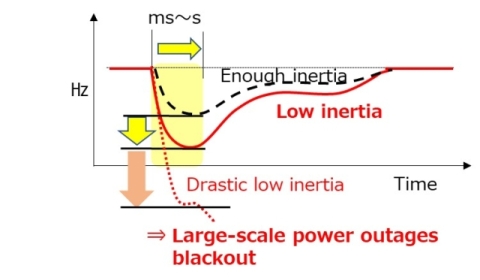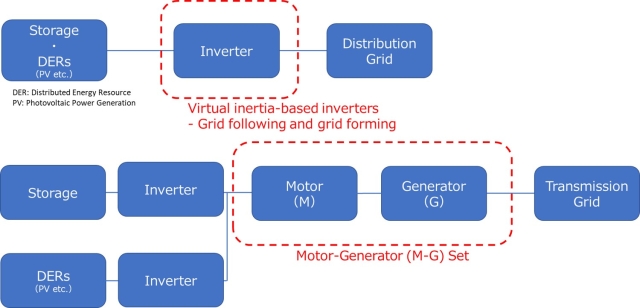Future-generation Power Network Stabilization Technology Development for Utilization of Renewable Energy As the Major Power Source (STREAM Project)
Project overview
In the extraordinary Diet session in October of 2020, the declaration was made to achieve carbon neutrality by 2050. Further, in the "Sixth Strategic Energy Plan" approved in October of 2021, the goal of a renewable energy (RE) ratio of around 36-38% by 2030 was announced. The importance of expanding RE adoption has been emphasized. To achieve this, the "Sixth Strategic Energy Plan" continues to address overcoming "grid constraints" for "utilization of renewable energy as the major power source" following the "Fifth Strategic Energy Plan." Expectations are high for achieving this through research and development.
In this project, based on the achievements of the NEDO project "Next-Generation Power Network Stabilization Technology Development for Large-Scale Integration of Renewable Energies," the latest technological and policy trends will be assessed. The focus will be on addressing both technical and institutional challenges in the future power system, considering the decrease in inertia*1 and the emerging issue of reduced short-circuit capacity*2. The developed technologies will be tested in a small-scale system to verify their effectiveness.
STREAM: Future-generation power network Stabilization Technology development for utilization of Renewable Energy As the Major power source
Research and Development
R&D Item [1]: Development for the Practical Application of Inverters With Synthetic Inertia*3
NEDO will develop equipment that combines inertial functionality and standalone operation detection functionality as current control (grid following) inverters and voltage control (grid forming) inverters, which are mainly targeted at distribution systems. In addition, NEDO will consider solutions and develop the necessary functions for issues such as the smaller fault current generated by inverters compared to rotating generators, which may result in inadequate fault detection. NEDO will verify the stable operation of the developed inverters with sysnthetic inertia when multiple units are introduced in a small-scale grid. Furthermore, NEDO will acquire data necessary for reflection in the Grid-interconnection Code etc.
R&D Item [2]: Development of Practical M-G Sets*4
NEDO will verify the development of M-G Sets connected to renewable energy and storage batteries to demonstrate behavior like conventional rotating generators even in the event of power system disturbance, contributing to the stability of the power system. Specifically, NEDO will verify that the renewable energy and storage batteries do not stop operating due to overvoltage and overcurrent on the system side of the motor (M side) of the M-G set in cases where the output of renewable energy decreases rapidly or when the charging and discharging of storage batteries are performed rapidly. In addition, by effectively utilizing storage batteries, NEDO will also verify grid stabilization control that is not available with existing synchronous generators, for example, the control to rapidly reduce power from storage batteries in the event of a ground fault on the backbone grid.
-

Figure 1 Impact of Low Inertia on Frequency Fluctuations (Concept) -
 Figure 2: Equipment Introduction Concept
Figure 2: Equipment Introduction Concept
*1 Inertia:
Inertia is the force possessed by generators such as thermal power generators (synchronous generators) that rotate the rotor to generate electricity. The rotor maintains a constant rotation and can withstand instantaneous electrical changes. On the other hand, power sources that supply electricity through inverters, such as solar power generation, lack a rotor and do not have inertia. Therefore, as renewable energy increases and generators with inertia, such as thermal power generators, decrease, there is a higher risk of widespread power outages in power systems that were previously able to maintain stable supply, especially in the event of instantaneous changes like power system accidents.
*2 Short-Circuit Capacity:
Short-circuit capacity indicates the magnitude of the current (short-circuit current) that flows instantaneously from a source or wire with a potential difference when a fault or accident occurs in the power system. Here, it is used to represent the indicator of the voltage maintenance capacity at that point. The magnitude and distribution of this current change complexly depending on the system configuration, the location of faults or accidents, and other factors.
*3 Inverter with synthetic inertia:
It is an inverter with inertia function emulating the behavior of synchronous generators. It is expected to contribute to mitigating the reduction in inertia as a system stability function.
*4 M-G Set:
A M-G set is a device that combines an electric motor (M: Motor) and a generator (G: Generator), allowing synchronization with the characteristics of synchronous generators for system stabilization while utilizing renewable energy.
Project Leaders
- PL: UEMURA Satoshi (Associate Vice President Head of ENIC Division Grid Innovation Research Laboratory, Central Research Institute of Electric Power Industry)
- SPL: BABA Jumpei (Professor, Graduate School of Frontier Sciences Department of Advanced Energy, The University of Tokyo)
Basic information
| Technical field |
|
|---|---|
| Project code | P22003 |
| Department in charge |
|
Last Updated : October 2, 2024
